Electricity, Magnetism, & Electromagnetism Tutorial
Introduction
Introduction
This resource provides an introduction to different topics in electricity and magnetism that you may find useful when doing background research for your Science Buddies projects. The information you will find here is sufficient for most of the projects on the Science Buddies website, but remember that there are entire books written about each topic, so there is much more to learn! We recommend reading the sections in order, but you can click on the links below to jump straight to a certain topic:
- Static Electricity
- Current Electricity
- Direct Current versus Alternating Current (DC vs. AC)
- Magnetism
- Electromagnetism
Credits
Sabine De Brabandere, PhD and Ben Finio, PhD, Science Buddies
Static Electricity
Static Electricity
Summary of Key Concepts
- Charged particles—often, negatively charged electrons—are the basis of electricity.
- Static electricity is the imbalance of positive and negative electric charges.
- Opposite electric charges attract; like electric charges repel.
What is static electricity?
We use electric devices like lights, radios, cell phones, computers, and many, many more every day. We connect the devices to an outlet in the wall or load them with batteries, but what exactly is electricity?
To understand electricity, we first need to examine the atom. Atoms are the basic building blocks of all material around us. They are made up of several smaller particles, including electrons. Electrons have a negative electric charge and whiz around a positively charged nucleus (made of positively charged protons, and neutrons, which do not carry electric charge) inside atoms. Sometimes these electrons escape and move around between atoms or get captured by a different atom. These escaped electrons are the basis of the electricity you use every day.
Some materials called insulators hold their electrons very tightly. Electrons do not move easily through these materials. Examples are plastic, wood, cloth, glass, or dry air. While electrons typically do not flow easily through insulators, it is still possible to transfer some electrons from one insulator to another. One common way is to rub two of these objects together. This creates an imbalance of positive and negative charges, called static electricity . If you have ever rubbed a balloon against a fabric and then stuck the balloon to a wall, that is an example of static electricity. Hair standing up on a cold winter day is another example of static electricity. Static electricity can build up on almost any material.
But do you know why the balloon sticks to the wall, or your hair stands on end? This happens because they become electrically charged, and electric charges push and pull on each other. Opposite charges (a positive and a negative) attract, or pull toward each other. Like charges (two positives or two negatives) repel, or push away from each other. Figure 1, below, shows this interaction between charges.
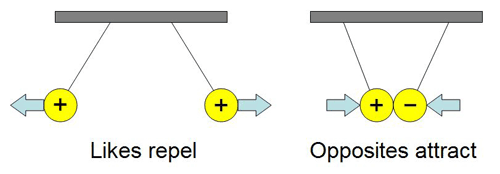 Image Credit: Ben Finio, Science Buddies / Science Buddies
Image Credit: Ben Finio, Science Buddies / Science Buddies
Figure 1. Like electric charges (two positive charges, as shown, or two negative charges) repel each other, or push each other away, while opposite charges (a positive and a negative charge) attract, or pull toward each other. This figure shows what would happen if you had electrically charged balls hanging from strings. Two like charges push away from each other, and two opposite charges pull toward each other.
Something similar to what is depicted in Figure 1 (left picture) happens when the hairs stand up on your head when taking off a wool hat on a cold winter day. Rubbing of hair against the wool hat electrically charges the hairs, and because all the hairs have "like" electric charges, they repel each other, so the hairs move as far away from each other as possible.
Sometimes, when enough static electricity builds up on an object, it will create a spark. A spark is when electrons jump through the air from one nearby object to another. This is called a static discharge. You may feel a tiny static discharge when you shuffle your feet across a carpet and then touch a metal object like a doorknob. Lightning is an example of a very large (and dangerous!) static discharge.
Technical Note
An atom that loses one or more electrons has more positive charges than negative charges (electrons). Therefore, it is positively charged. An atom that captures one or more extra electrons obtains a total negative charge. Charged atoms are called ions.
Related Science Projects
Here is a list of science projects related to static electricity.
Current Electricity
Current Electricity
Summary of Key Concepts
| Variable | Description | Unit | Unit Abbreviation |
|---|---|---|---|
| Charge | Quantity of electricity; can be positive, negative, or neutral. | Coulomb | C |
| Current | Amount of electric charge passing through an area per second. | Ampere | A |
| Voltage | Also called electric potential, or the "pressure" that makes current flow. | Volt | V |
| Resistance | How difficult it is for current to flow. | Ohm | Ω |
| Power | Energy used or produced per second. | Watt | W |
What Is an Electric Current?
Charged particles are at the basis of all electricity. Static electricity is a phenomenon caused by electric charges at rest. In this section, you will study what happens when charged particles start moving collectively. We will discuss electrons as carriers of charge, but other types of particles can also carry charge. See the Technical Note: Direction of Electric Current for more details.
Certain materials have some loosely held electrons, which can escape from one atom and move around easily between other atoms. We call these electrons free electrons. Materials with a lot of free electrons are called conductors. They conduct electricity well. Most metals are good conductors.
When a lot of free electrons are all moving in the same direction, we call it an electric current. The amount of electric current refers to the number of electrons (to be precise, their charges) passing through an area per unit of time, and is measured in amperes (usually called amps for short, abbreviated with a capital A). One ampere equals roughly 6.24 × 1018 or 6.24 quintillion electrons passing in 1 second. Because the electron has such a small charge, the coulomb (abbreviated with a capital C) is often used as unit of charge for 6.24 × 1018 electrons. In these units, 1 ampere (A) is a current created by 1 coulomb (C) passing per second. Because electrons carry a negative charge and a coulomb refers to a positive charge, some definitions are needed. These are explained in the Technical Note: Direction of Electric Current.
Just like water needs a pressure difference to start flowing, electrons require an electric potential difference to make them move. The potential difference provides the energy to create movement. Electric potential difference is also called voltage and it is measured in volts (abbreviated V). In the case of water, pressure can be created by a water pump or difference in height, like a water tower. In electronics, batteries and electric generators are the common sources of voltage. The presence of two different charges also creates a voltage; it gives the electric charges the energy to flow.
Conductors allow current to flow through them easily, and charges do not lose much energy as they flow through these materials. Similar to how water gets slowed down when it encounters a smaller section in a pipe, electric current can encounter materials that are harder to get through. This obstruction to flow is quantified by a variable called resistance and measured in ohms (abbreviated Ω). The higher the value of the resistance, the more the material hinders (or resists) the current, and the more energy is lost as current flows through it. The voltage, the current it generates, and the resistance are related; this relationship is now known as Ohm's law and states that voltage is equal to current times resistance, or in equation form:
Equation 1:
The total electric energy provided by a source is the amount of charge times the voltage. A source providing a larger voltage or more charges (more electrons) will both result in delivering more electric energy, which, in turn, allows it to power "heavier" electric devices or appliances. The Technical Note: Energy Consumed explains this in more detail.
Technical Note: Direction of Electric Current
Electrons, being small and light, move easily and create the bulk of electric current we encounter, like current received from wall sockets or produced by most batteries. For this reason, we will continue to discuss electricity as the flow of electrons. Sometimes, electric current is created by the flow of other charged particles, like ions (atoms that have a net electric charge due to a lack or surplus of electrons). To accommodate all variations, electric current is more accurately defined as the amount of electric charge passing per unit of time, regardless of what particles carry the electric charge.
So far, we have only described the amount of current. The direction is given by the sign (positive or negative) of the current. Conventionally, positive electric current is opposite the direction of electron flow. This is called the conventional current. This means that if you draw an arrow in the direction electrons are moving through a wire, the conventional current points in the opposite direction.
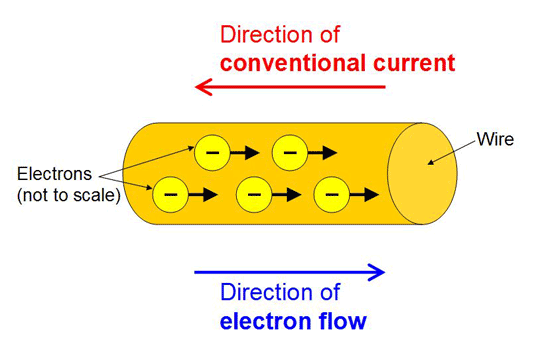 Image Credit: Ben Finio, Science Buddies / Science Buddies
Image Credit: Ben Finio, Science Buddies / Science Buddies
Figure 2. If the current is represented by a positive variable (referred to as the conventional current, represented by a red arrow in the figure), the arrow representing the direction of current will point opposite to the movement of the electrons (represented with a blue arrow).
Batteries are often used as a source of electric current. A battery has a positive terminal, marked by a "+" symbol, and a negative terminal (although "-" is the symbol for negative, it is usually not printed on the battery). The negative terminal has a surplus of electrons, giving it a net negative charge. These electrons flow from the negative terminal to the positive terminal when there is a conductive path connecting them. The direction of conventional current is opposite this—from the positive terminal to the negative terminal, as shown in Figure 3.
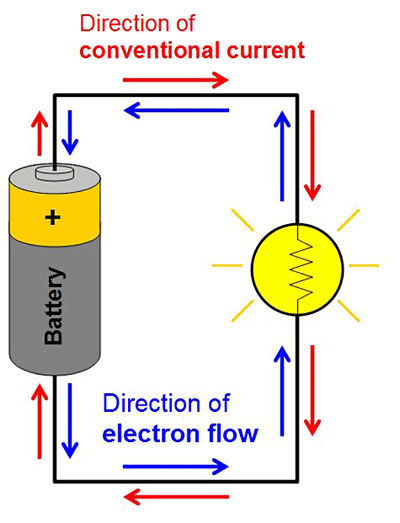 Image Credit: Ben Finio, Science Buddies / Science Buddies
Image Credit: Ben Finio, Science Buddies / Science Buddies
Figure 3. When conductive material connects the two terminals of a battery, electrons will flow from the negative to the positive terminal. The conventional current will point from the positive to the negative terminal.
Technical Note: Energy Consumed
Most of our appliances specify how much electric energy they require per second they are in use. This is called a power expressed in watts (abbreviated W). Power represents the amount of electric energy (or voltage times charge) consumed by the appliances per second it is running. If you write these relationships out in equation form:
Equation 2:
Equation 3:
Equation 4:
And then rearrange the equations a bit (try this out if you know how to do algebra) you can see that electric power is equal to voltage times current:
Equation 5:
And that energy is equal to power times time:
Equation 6:
Your electric bill expresses your use of electric energy in kilowatt-hours. 1 kilowatt-hour represents the use of 1,000 watts (W) for 1 hour (h). However, note that the electricity supplied to your house by power lines is alternating current, meaning the voltage and current change with time instead of remaining constant. This is explained in the next section.
Related Science Projects
Here is a list of science projects related to electric current.
DC vs AC
DC vs AC
Summary of Key Concepts
- Current can only flow in a closed circuit of conductive material.
- In direct current (DC), electrons all move in the same direction. In alternating current (AC), electrons move back and forth with a specific frequency measured in hertz (Hz).
- Caution: Never plug a homemade circuit directly into a wall outlet; the alternating current from the wall outlet can harm you badly.
How Current Flows: DC vs. AC
In the Current Electricity section, you learned about electric charge, current, voltage and other related topics. But, just because you have a voltage does not mean electric current will flow. Electrons also need a complete loop of conductive material to flow, called a closed circuit.
Let's look at a light switch. When you turn the switch "on", the switch creates a path that conducts electricity and electrons start to move—meaning electric current flows—and the light turns on. As soon as you turn the switch "off", the path is broken and electrons can no longer flow. The switch is like a drawbridge; switching it on is letting down the bridge so the electrons can cross (just like cars crossing a bridge) and provide energy to the light bulb.
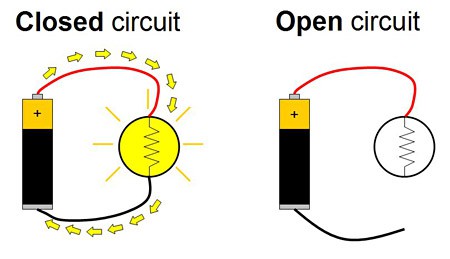 Image Credit: Ben Finio, Science Buddies / Science Buddies
Image Credit: Ben Finio, Science Buddies / Science Buddies
Figure 4. Illustration of how electric current can move through a closed loop of conductive material (left figure) but stops flowing whenever the loop is broken (right figure). This figure shows how a light bulb lights up when it is connected to a closed circuit. Note the yellow arrows show the direction of the conventional current.
So remember, in order for electric current to flow, there must be a closed loop of conductive material. There are two different ways in which electrons can move through a loop of conductive material and create an electric current: direct current and alternating current.
In the case of a direct current (abbreviated DC), the electrons always travel around the loop in the same direction (so the conventional current also has a constant direction). Figure 5, below, shows a direct current, or electrons all moving in one direction in a conductive wire. All battery-powered devices, like cell phones and flashlights, run on direct current. Note that a constant voltage will create a direct current.
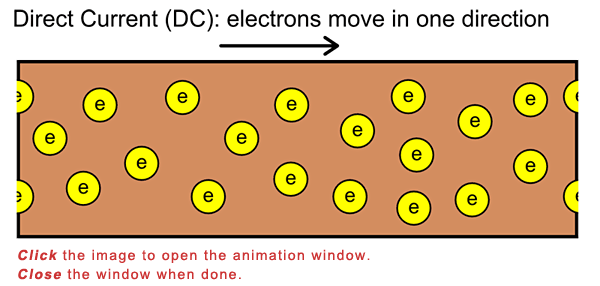 Image Credit: Science Buddies
Image Credit: Science Buddies
Figure 5. In the case of direct current (DC), the free electrons always collectively move in the same direction. Important: This figure is not to scale. Read the technical note, below, to get a more accurate description.
In the case of an alternating current (AC), electrons travel back and forth. Figure 6, below, shows an animation of alternating current. One moment they all move collectively in one direction, and the next moment they all move collectively in the opposite direction, creating an oscillating electrical current. One back-and-forth oscillation is called a cycle, and the number of cycles delivered per time unit is called the frequency. Frequency is measured in hertz (Hz). One cycle per second is 1 Hz, ten cycles per second is 10 Hz, etc. Note that the voltage creating this current will alternate with the same frequency.
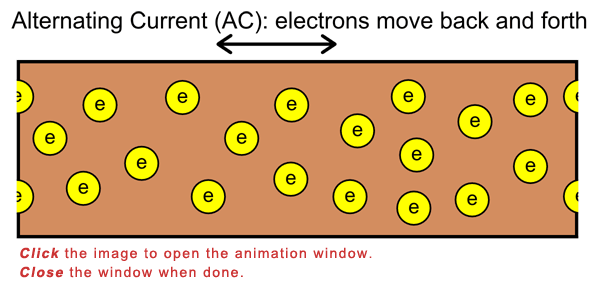 Image Credit: Ben Finio, Science Buddies / Science Buddies
Image Credit: Ben Finio, Science Buddies / Science Buddies
Figure 6. In the case of alternating current (AC), the free electrons collectively move back and forth. Remember, just like in Figure 5, this figure is not to scale. Read the technical note, below, to get a more accurate view.
Power lines deliver alternating electric current to our homes. Depending on what country you are in, alternating current from power outlets is usually 50 or 60 cycles per second (Hz). Most electric appliances we "plug into the wall" run on alternating current. Some appliances need an "adapter" or "converter" to convert alternating current to direct current, like a cell phone charger.
Technical Note
When looking at the figures above, always remember that for a current of 1 amp (A), there are actually quintillions of electrons going through a conducting wire per second. Also, these electrons do not actually move in a straight line. In reality, electrons bounce all around between atoms in a conductor, as illustrated in Figure 7, below. The overall drift toward one direction creates the electric current. Remember that the direction of conventional current is opposite the direction of electron motion, as shown in the figure.
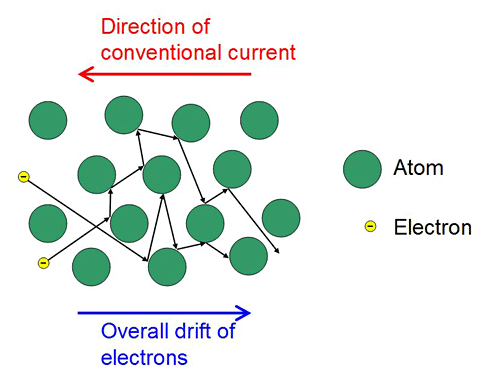 Image Credit: Science Buddies
Image Credit: Science Buddies
Figure 7. Illustration of how electrons bounce around between atoms in a conductor where the overall drift in one direction creates the electric current. Note that this figure is also not to scale—electrons are much smaller than atoms, but they are so tiny that it is impossible to draw an accurate to-scale figure where you can see the electrons.
To understand the difference between AC and DC, you can also make a graph of electric current versus time. For direct current, the current is constant (a straight line). For alternating current, the current oscillates back and forth:
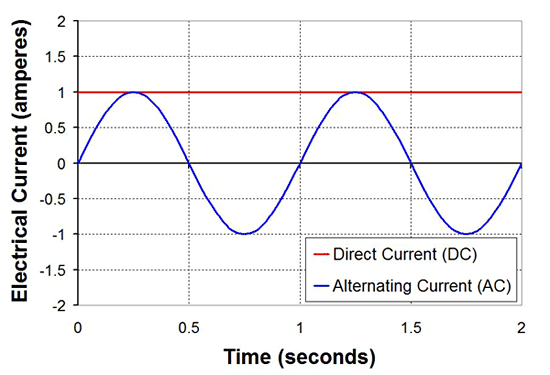 Image Credit: Ben Finio, Science Buddies / Science Buddies
Image Credit: Ben Finio, Science Buddies / Science BuddiesExample graph of amperes over time show alternating and direct currents. The alternating current in blue has an ampere value that changes from a positive 1 to a negative 1 forming a wave with constant frequency. The direct current is a straight horizontal line in red that maintains a constant ampere value of 1.
Figure 8. Graphical representation of current (y-axis) versus time (x-axis) of direct current and alternating current. In this figure, the alternating current completes one cycle every second, i.e. it has a frequency of 1 Hz. Note that a negative current represents a current in the opposite direction.
Safety Tips
Electricity can be dangerous for humans. Actually, our brains, muscles and nerves run on tiny electrical signals. A small and short shock from a small amount of electric charge running through your body will not hurt you. Larger amounts of electricity, however, can interfere with the electrical signals in your body (for example, the signal that makes your heart beat regularly), and can create heat that can burn tissue, so always be careful with electricity. Most home science projects involve battery-operated circuits. While there are some safety precautions you need to follow when using batteries (for example, if there is a short circuit, the batteries and wires connected to them can get very hot, and the batteries can even explode), in general batteries are not a serious electric shock hazard. However, the alternating current from wall outlets in your home is very dangerous. You should never attempt to use electricity directly from a wall outlet to power a homemade circuit, unless you are having an adult help you use an AC/DC converter (a device that converts AC from a wall outlet to safe levels of DC, such as cell phone and laptop chargers).
Related Science Projects
Here is a list of science projects related to making circuits, and a list of projects related to electric current.
Magnetism
Magnetism
Summary of Key Concepts
- Every magnet has a north pole and a south pole. A north and a south pole attract each other, whereas similar poles (north-north or south-south) push each other away.
- Magnets are surrounded by a magnetic field, which creates a push or a pull on other magnets or magnetic materials in the field.
- Magnets (especially neodymium or rare earth magnets) can be dangerous; always read the safety precautions before you handle them.
What is Magnetism?
The following pages explain the science behind how magnets work. Before you continue reading, watch our short video about magnetism:
When playing with magnets, you probably noticed that a magnet can be used to attract certain materials or objects, but not others. Figure 9, below, shows a magnet picking up metal screws and paper clips, but having no effect on wood, rubber, Styrofoam®, or paper.
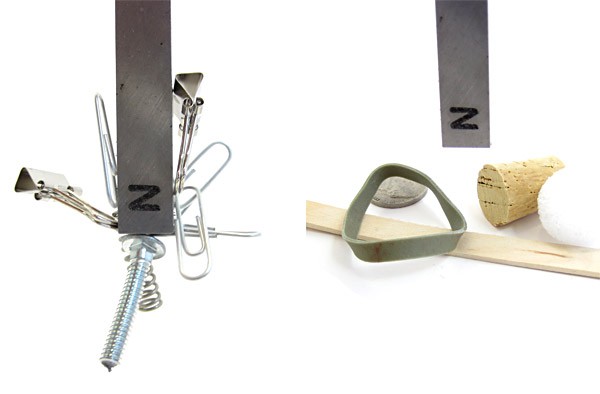 Image Credit: Ben Finio, Science Buddies / Science Buddies
Image Credit: Ben Finio, Science Buddies / Science Buddies
Figure 9. A magnet can be used to pick up many metal objects, like screws or paper clips (left), but has no effect on some materials, including plastic, rubber, wood, or even certain metals (right).
If you have ever played with two or more magnets at once, you probably noticed that magnets can either attract or repel each other, depending on how they are positioned. This is because every magnet has a north pole and a south pole. Opposite poles attract each other (north and south) and similar poles repel each other (north-north or south-south). Magnets are often labeled with an N for the north pole and an S for the south pole, as shown in Figure 10.
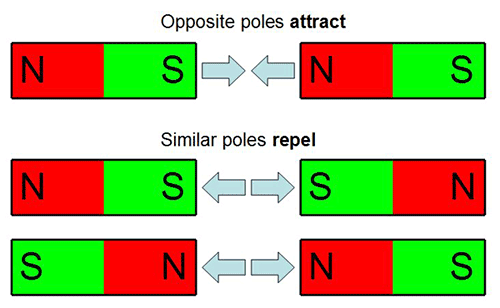 Image Credit: Ben Finio, Science Buddies / Science Buddies
Image Credit: Ben Finio, Science Buddies / Science Buddies
Figure 10. Every magnet has a north pole and a south pole. Opposite poles pull toward each other, and similar poles push away from each other.
If you watched the video above, you may have noticed that magnetic poles can push and pull on each other without touching each other. Magnets can do this because they are surrounded by a magnetic field. It is the magnetic field that creates the force (a push or a pull) on other magnets or magnetic materials in the field. The magnetic field gets weaker as you get farther and farther away from a magnet; so magnets can be very strong up close, but they do not have much of an effect on objects (like other magnets) that are very far away.
Magnetic fields are invisible; you cannot see them with your eyes. So, how do we know they are there, or what they look like? Scientists represent the invisible magnetic field by drawing magnetic field lines. These are lines that point from the north pole to the south pole outside of the magnet (inside the magnet they point from the south pole to the north pole). The magnetic field is strongest (or the magnet has the strongest pull or push on other magnetic material) where these lines are bunched closely together, and weakest where they are spaced farther apart. A common way to visualize magnetic field lines is to sprinkle many tiny iron filings near a magnet. The iron filings line up with the magnetic field lines, as shown in Figure 11.
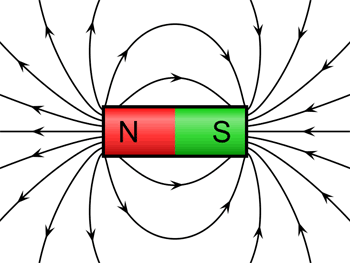
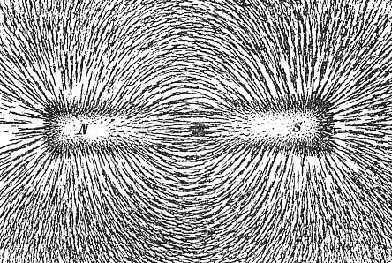 Image Credit: Wikimedia, Newton Henry Black / Public Domain
Image Credit: Wikimedia, Newton Henry Black / Public Domain
Figure 11. On the left, magnetic field lines point from the north pole of a magnet to the south pole outside the magnet (image credit Wikimedia Commons user Geek3, 2010). On the right, you can see these lines using iron filings.
You can also detect a magnetic field by using a compass. A compass—like the one shown in Figure 12—is actually a small bar magnet that is free to rotate on a pivot.
 Image Credit: Ben Finio, Science Buddies / Science Buddies
Image Credit: Ben Finio, Science Buddies / Science Buddies
Figure 12. A compass is a device with a rotating magnetic needle that can be used to navigate. The N, S, E and W on the compass stand for north, south, east, and west, respectively. In this image, the N and S are partially hidden behind the needle.
Normally, a compass will align with Earth's magnetic field, so its needle will align itself roughly with the geographic north-south direction (not perfectly, though; there is actually a slight offset between Earth's magnetic and geographic poles). This means that a compass can be used to navigate so you can determine which directions are north, south, east, and west. However, if you bring a compass very close to another magnet, that magnet will have a stronger effect on the needle than Earth's magnetic field. The compass needle will align with the local (or "nearby") magnetic field (the lines shown in Figure 11).
Technical Note
Earth actually acts like it has a big "upside-down" bar magnet inside of it. The south pole of that bar magnet is actually near (but not perfectly lined up with) Earth's north pole, and vice versa. So, the part of a compass needle (usually the red end) that points toward the south pole of a magnet (like in Figure 13), will point toward Earth's geographic north pole. This can be confusing; just look at Figure 13 if you need to remember which end of the compass needle is which!
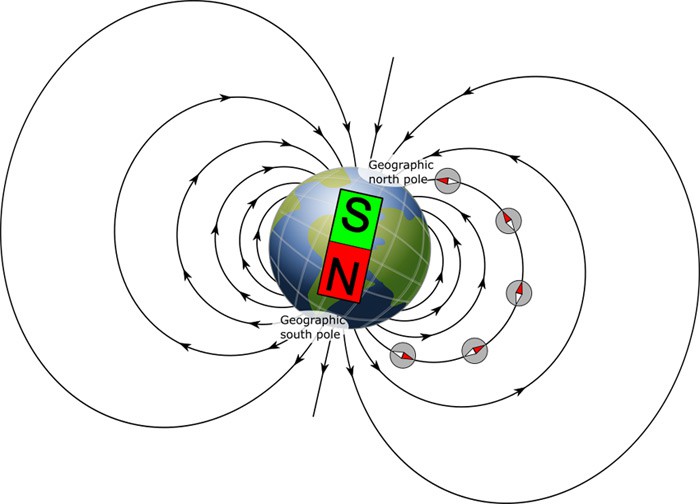 Image Credit: Wikimedia Commons user Zureks / Public Domain
Image Credit: Wikimedia Commons user Zureks / Public Domain
Figure 13. You can imagine Earth's magnetic field like there is a giant bar magnet buried inside Earth. The magnet's south pole is close to Earth's geographic north pole, and the magnet's north pole is close to Earth's geographic south pole. Earth's magnetic and geographic poles do not line up with each other perfectly, but they are very close.
There are several different types of magnets. Permanent magnets are magnets that permanently retain their magnetic field. This is different from a temporary magnet, which usually only has a magnetic field when it is placed in a bigger, stronger magnetic field, or when electric current flows through it. The bar magnet and paper clips from Figure 9 are examples of permanent and temporary magnets, respectively. The bar magnet is always surrounded by a magnetic field, so it is a permanent magnet. The paper clips do not normally have a magnetic field; in other words, you cannot use one paper clip to pick up another paper clip. However, when you bring the bar magnet near the paper clips, they become magnetized and behave like magnets, so they are temporary magnets. Another type of temporary magnet, called an electromagnet, uses electricity to create a magnet. See the Electromagnetism section to learn more about electromagnets.
Technical Note
In everyday language, we usually just refer to magnets, and materials that are attracted to magnets, as "magnetic." Technically, these materials are called ferromagnetic. It is important to note that not all metals are ferromagnetic. You will notice this if you try to pick up a copper penny or a piece of aluminum foil with a magnet. The most common ferromagnetic metals are iron, nickel, and cobalt.
Ferromagnetic material contains many tiny magnetic domains at the microscopic level. Each magnetic domain has its own tiny magnetic field with a north and a south pole. Normally, these domains point randomly in all different directions, so all the tiny magnetic fields cancel each other out, and the overall material is not surrounded by a magnetic field. However, when a material is magnetized (usually by putting it in a strong magnetic field), all of these tiny magnetic fields line up, creating an overall larger magnetic field.
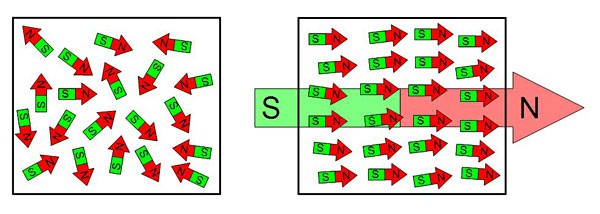 Image Credit: Ben Finio, Science Buddies / Science Buddies
Image Credit: Ben Finio, Science Buddies / Science Buddies
Figure 14. In ferromagnetic material, tiny magnetic fields can be oriented randomly in different directions, canceling each other out. In this case, the material will not show magnetic characteristics (left). When the magnetic fields line up and all point in the same direction, they combine and create a large magnetic field. The material will then show the characteristic of a magnet (right).
How, exactly, the tiny magnetic fields are generated depends on how electrons move inside atoms. This is one example of how magnetism and electricity are connected.
- To learn more about electrons and electricity, see the Static Electricity section.
- To learn more about how magnetism and electricity are connected, see the Electromagnetism section.
Safety Tips
Magnets are fun and useful, but can also be dangerous if they are not handled properly. Small magnets should always be kept away from small children and pets, because they can cause serious injury if they are swallowed. Very strong magnets, like neodymium magnets, can pull together with a very high force, pinching your fingers if they are caught in between. You should always keep magnets away from electronic devices, like computers and cell phones, and away from credit cards (or any other card with a magnetic strip). This is because the data on these devices is often stored using magnetic recording, and can be erased when it comes close to a strong magnetic field. If you are doing a Science Buddies project involving magnets, be sure to read the safety precautions for that specific project before you start.
Related Science Projects
Here is a list of science projects related to magnetism.
Electromagnetism
Electromagnetism
Summary of Key Concepts
- Electromagnetism includes the study of electricity, magnetism, and how they are connected.
- An electromagnet is a temporary magnet that only generates a magnetic field when electric current is flowing.
- Some electromagnets create very strong magnetic fields when current is flowing.
What Is Electromagnetism?
Note: We recommend reading the section on Magnetism and watching our introductory video before you read the section about electromagnetism. The video includes a segment about electromagnets.
Electricity and magnetism are very closely related. The study of both, and how they are connected, is called electromagnetism. This page is just a brief introduction to electromagnetism, and contains information you may find useful for Science Buddies projects. There are entire textbooks written about electromagnetism, though; this is just the beginning!
One common example of the interaction between electricity and magnetism is an electromagnet. An electromagnet is a special type of temporary magnet that only generates a magnetic field when electric current is flowing (you can learn more about electric current in the Current Electricity section). This makes electromagnets very convenient because they can easily be turned on or off, and can create very strong magnetic fields.
A single, straight wire with current flowing through it creates a circular magnetic field configuration, as shown in Figure 15.
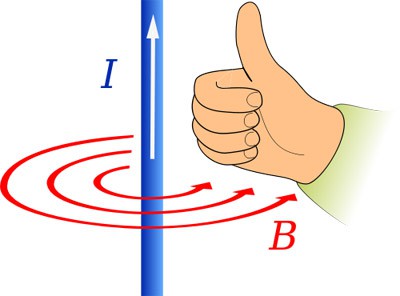 Image Credit: Wikimedia Commons user Jfmelero / Creative Commons Attribution Share-Alike 3.0 Unported
Image Credit: Wikimedia Commons user Jfmelero / Creative Commons Attribution Share-Alike 3.0 Unported
Figure 15. This illustration shows the magnetic field around a current-carrying wire. The current (capital letter "I") is represented by the white arrow. The magnetic field (capital letter "B") is represented by the red arrows. You can use your right hand, as depicted, to determine the direction of the magnetic field. See the technical note, below, for more information about the "right-hand rule." (image credit Wikimedia Commons user Jfmelero, 2008)
Technical Note
The hand in Figure 15 represents the right-hand rule, used to predict the direction of the magnetic field induced (or created) by a current. When you point the thumb on your right hand in the direction of current flow, your fingers curl in the direction of the magnetic field. If the current reverses direction, the magnetic field lines will also reverse direction.
A bigger current will produce a stronger magnetic field. However, even a strong current in a straight wire does not make a very strong electromagnet. To make a much stronger electromagnet, you can wrap the wire into a coil, as shown in Figure 16. The magnetic field near a coil of wire looks very similar to the magnetic field near a bar magnet. (Can you figure this out using the right-hand rule explained above?) Just like with a straight wire, if the electric current reverses direction, the magnetic field around the coil will also reverse direction.
 Image Credit: Wikimedia Commons user Zureks / Public Domain
Image Credit: Wikimedia Commons user Zureks / Public Domain
Figure 16. When there is no current flowing through a wire coil, there is no magnetic field (top). When electric current flows through the coil, it creates a magnetic field very similar to the field around a bar magnet, represented by the green/red arrow in the coil (middle)). If the direction of the current reverses, the direction of the magnetic field also reverses (bottom).
To make an electromagnet even stronger, you can wrap the coil around a ferromagnetic core, as shown in Figure 17 (refer back to the Magnetism section to learn about ferromagnetic materials). That way, when the electromagnet turns on, it magnetizes the core. The magnetic fields of the coil and the core then add up, creating an even stronger electromagnet.
 Image Credit: Ben Finio, Science Buddies / Science Buddies
Image Credit: Ben Finio, Science Buddies / Science Buddies
Figure 17. Many electromagnets are made by wrapping wire around a ferromagnetic core (like a nail or a bolt). When the coil is not powered by a battery or other source of electricity (open circuit), no magnetic field is present, as shown in the picture to the left. When the coil is connected to a battery and electric current flows through it (closed circuit), a magnetic field is created, allowing the electromagnet to pick up the paper clips, as shown in the picture to the right. When the current shuts off again (circuit is opened again), the magnetic field goes away, and the paper clips are dropped. You can see this effect much more clearly in our Introduction to Magnetism video.
An electric current is nothing more than moving electric charges. Anytime an electric charge moves, a magnetic field is created. You might wonder if moving magnets (or a changing magnetic field) would create an electric current or get electric charges to move. The answer is yes, it can. This aspect of electromagnetism is often used to create electricity in electric generators. You can learn more about the link between electromagnetism and generating electricity in some of the hands-on projects linked below.
Related Science Projects
Here is a list of science projects related to electromagnetism.





